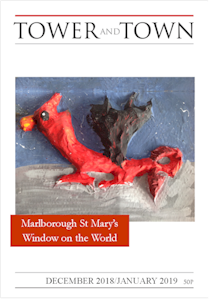

Tower and Town, December 2018 (view the full edition) (view the full edition)An Oral History (part 1)The Marlborough History Society has kindly given us permission to publish extracts from Muriel Cobern's fascinating oral history of life in Marlborough. One of the highlights of my childhood in Marlborough during the 1930s was our annual trip - usually at the end of the summer, or just after Christmas - to see my father's parents in Surrey. Although we never stayed more than a few days as my father was always anxious to get back to the business, these trips did involve some planning, including making arrangements with my mother's sister at Manton to come in every day to feed Jimmy the cat. My grandparents were both Wiltshire born and bred - grandfather from Whiteparish and Granny from Marlborough - so we always took them the good old Wiltshire fare of a lardy cake and a hock of bacon, and when we went at Christmas, one of my mother's delicious home-made Christmas puddings, the ingredients for which, along with the cake and bacon, she bought at the International Stores at 127 High Street, although in those days Marlborough had plenty of other grocery shops to choose from. In the High Street alone, apart from the Inter, as it was popularly called, was HW Pocock Grocer at No. 129, Pocock Grocer at Nos. 2/3, the Co-op at No. 7, Mrs. Bennet Grocer at No. 19, and Stratton Sons and Mead at No. 25. While, at the bottom end of Kingsbury Street, Irvings Grocery Store occupied Victoria House at No. 1, and almost opposite in Dormy House was Figgins Grocery Shop. In the Parade, No. 3 was occupied by Burchells the Grocers and No.12 by Cumnors Grocery Store. All were sizeable shops and most, albeit with some changes of ownership, were still in existence for several years after the end of the War. On the morning of our departure, we would leave our house in St. Martins and make our way down through The Green and Barn Street, along the London Road and into Salisbury Road, where, soon after leaving the George Lane turning, we came to the old Monastery, built on the site of the Gilbertine Priory of St. Margaret. This seventeenth century house, sinister and forbidding behind its screen of trees, was already showing signs of the degeneration that would eventually destroy it. I always passed it with some trepidation, for its reputation was fearsome, to say the least. Many people would not go anywhere near it, preferring to walk by on the other side of the road, lest one of the ghosts that were said to haunt it should suddenly appear. I was too young then to understand its fascinating history, or know about the interesting people who had lived there, but knew only lurid tales about headless monks and wandering spirits. Muriel Cobern |